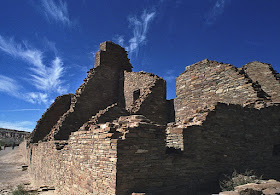We drove to Chaco Canyon and spent the afternoon walking through the three Anasazi Great Houses that are close together near the end of the loop road: Pueblo Bonito, Chetro Ketl and Pueblo del Arroyo.
All the pictures were made with my Pentax Spotmatic and the 24mm Super-Takumar lens. The Fuji 200 film was processed with the Unicolor C-41 kit.











The blue in those skies is astonishing, especially knowing you captured them on Fujicolor 200. I don't think of that film as being especially generous with the blues.
ReplyDeleteI would so love to try processing color someday. Something makes me think it is a difficult and fussy process.
ReplyDeleteVery nice shots from the Spotmatic and Super Tak! Keep 'em coming!
I think the film did do a good job of capturing the sky color. The high contrast lighting at mid-day presents a challenge for capturing shadow detail, but it does favor the sky. Also, of course, one has to give credit to the extraordinary skies of New Mexico. The blue sky color is pretty intense anywhere in the state, but particularly in the North at the high elevations. Chaco Canyon is about 7,000 feet, nearly the same as Santa Fe.
ReplyDeleteI was intimidated by the idea of color processing until just a couple years ago when I tried the Unicolor C-41 kit. It turns out that color is really no harder than b&w; nor is it more expensive or more time consuming. Unicolor promises a dozen rolls per kit, but I've had the current one for about a year and have lost count of the number of rolls I've processed with it. I thought the last two rolls looked fine, but I probably will order a new kit now; I think they go for about twenty-five bucks. Take a look at my "diy color" post for some of the details:
http://connealy.blogspot.com/2015/01/diy-color.html
Beautiful photos Mike. Seeing as I will soon (I hope!) be starting to develop my own black and white negatives I can't even contemplate trying colour. I remember a photographer friend in college running me through the process years ago. Having said that you seem to have a knack for simplifying complicated processes with your - what's all the fuss about attitude :-) Your clear and simple instructions for using 120 film in a Kodak 1a is a case in point. It's helped me and a lot of others get photos from these lovely old beauties.
ReplyDeleteIt is helpful to get some hands-on instruction initially from someone who knows what they are doing without being overly compulsive about the process. I was first introduced to b&w processing in a small class of people like myself with zero exposure to film developing. We were given Rondinax developing tanks which are very easy to load. The developer was a small bottle of Rodinal from which we were told to extract an eye-dropper of the liquid to squirt into a measuring cup of tap water. I don't recall much concern about time and temperature. The negatives came out fine.
ReplyDeleteMore recently, I went through a similar class conducted by Becky Ramotowsky on developing film with caffenol, a mixture of water, instant coffee and vitamin C. The whole process was conducted informally and without much opportunity to measure anything, but again with rewarding results. Modern b&w films are very forgiving of processing errors and likely to give usable results if you can get anywhere near the ideal time, temp and dilution. I think part of the success of Becky's demo was that she gave us just an hour to shoot up a roll of film for the class, so we all came back without a lot of anxiety about messing up any timeless images.